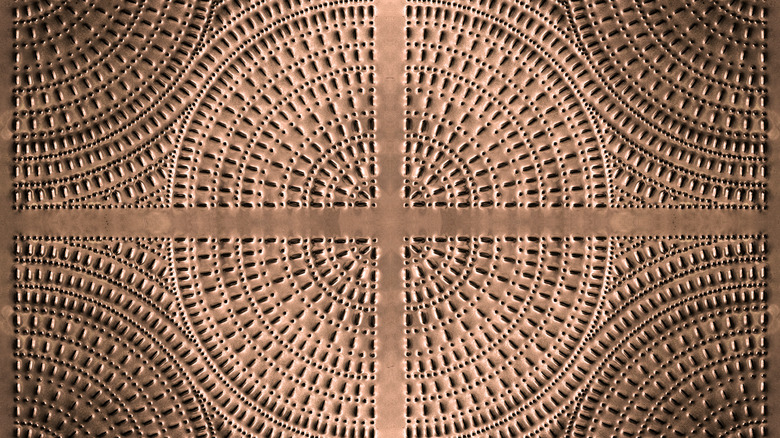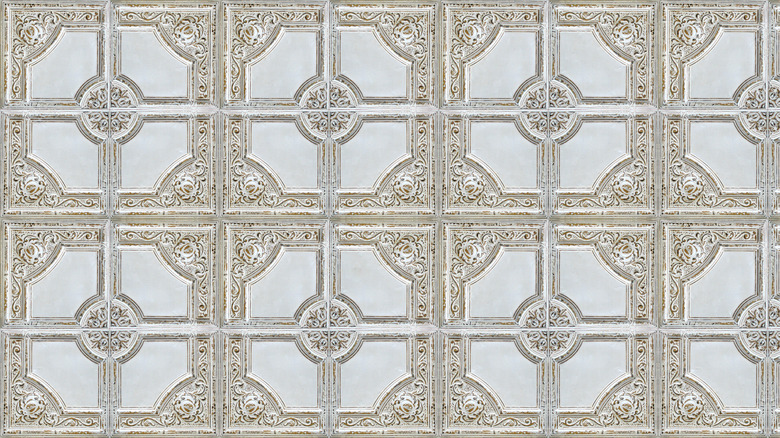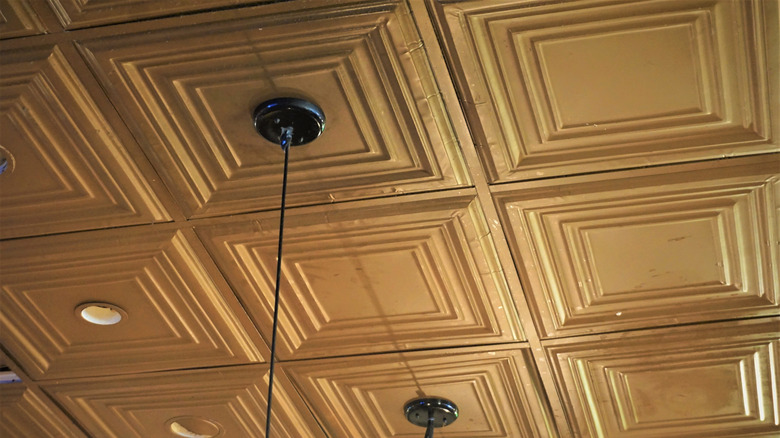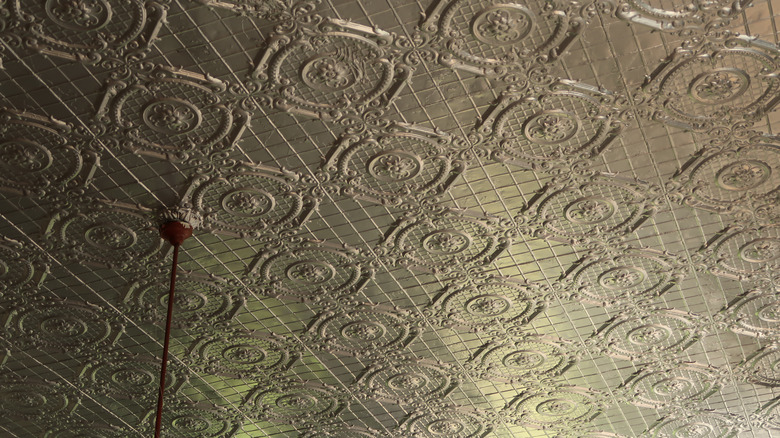Are Tin Ceilings Coming Back In Style?
A great source of inspiration in home décor can be found by looking at the past. Pressed tin ceilings are a part of American architecture, popular during the late 1800s to early 1900s, per Brian Greer's Tin Ceilings. They are resurging today as people appreciate how easy it is to create a visual impact in their homes by decorating the "fifth wall" — the ceiling. Affordable, durable, and stylish, tin ceilings are a great way to add a unique touch to your home.
In the early 1900s, ornamental plaster ceilings were the height of luxury and popularity in Europe. This handiwork was expensive to duplicate in one's home, and the plaster was easily susceptible to water damage. In America, the idea of the pressed tin ceiling was born, which could be painted white to mimic the look of a European plaster ceiling. The metal is pressed with a die to create a pattern repeated across the space for a striking impact. The tiles are often made of tin-plated steel, although other metals such as copper, chrome, or brass can also be used, via Brian Greer's Tin Ceilings. The choice of tin ceilings dipped after 1930 as World War II required metal to be donated to the war effort. After the war, home design became more minimalist, and tin ceilings became a part of nostalgia. However, they have risen to new popularity in recent years as homeowners find value in adding historic and vintage charm to their modern homes.
Uniquely designed
Tin ceilings were developed at the same time the Arts and Crafts Movement took hold in America at the turn of the 20th century. This philosophy believed that artisan craftsmanship and using natural materials, such as metal, added authenticity to a home. Most companies that produce these tiles today still apply the finishes by hand, creating a one-of-a-kind look to complement the particular style of any home, via American Tin Ceilings. A visitor will not often look up and admire a plain, white ceiling, but a uniquely designed tin ceiling will always garner attention and admiration.
There are several ways to personalize a tin ceiling and make it unique for your home. You can create a new pattern for the pressed design, or one can be duplicated from one used in a historic building, such as a train station, bank, hotel, or courthouse, via Brian Greer's Tin Ceilings. The selection of finishes can range from variations of white, copper, bronze, or black, or the metal can be clear-coated. The embossed details of the design can be painted a different color from the rest of the tile, highlighting the architectural detail and complementing the room luxuriously. Decorative fillers can be placed between the tiles, or cornices can be added along the perimeter of the ceiling tiles.
Durable and affordable
The durability of a tin ceiling cannot be matched by other materials such as plasterboard or drywall. Tin ceilings have been known to outlast many of the historic buildings in which they were originally installed, according to Brian Greer's Tin Ceilings. This resilience makes a tin ceiling cost-effective in a number of ways. Being resistant to water damage will prevent costly repairs and protect the structural integrity of your home if there is a leak, via Metal Ceiling Express. Tin ceiling tiles are also fireproof and easy to clean, making them a good investment for your safety as well as your pocketbook.
Their endurance will save money when it comes time to remodel your home in the future as well. By painting the ceiling tiles a new color or changing the finish, it's easy to transform the overall look of a room completely. This kind of flexibility means that the tiles don't need to be removed or replaced to update your home décor, which can add to the value of your home. Already a very affordable choice, the decision to install a tin ceiling becomes even more worthwhile over time.
Stylish
Use your imagination to decide where you want to bring dimension to a room by adding a tin ceiling. Cover the expanse of the living room overhead with a bold geometric pattern, or create a focal point over a kitchen island. Choose an intricate pattern based on an antique Victorian design, or make a statement with an art deco format, via American Tin Ceilings. A tin ceiling that is painted white adds a design element to a modern kitchen or bathroom. The material's resistance to moisture makes it a perfect addition to these areas and any seaside retreat that experiences fog or damp weather.
Create an industrial look simply by applying a clear coating to the natural metal, per Arts and Crafts Homes. An oil-rubbed bronze or copper finish will complement a room decorated in a Tuscan palette. Or use an espresso patina to bring a warm ambiance to a bar, den, or study. There are endless patterns and finishes to choose from when designing a tin ceiling. It is an architectural detail that represents the distinct style of a home and the homeowner who plans it. A tin ceiling also reflects the unique beauty of preserving the past by incorporating it into the modern day.



